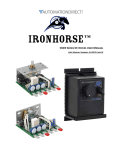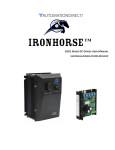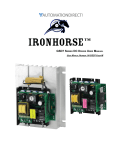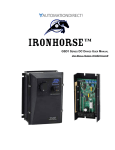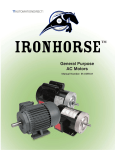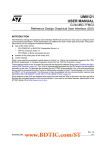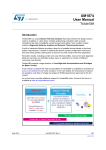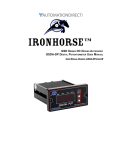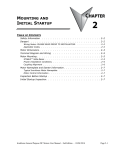Download Chapter 3 - AutomationDirect
Transcript
Maintenance and Troubleshooting Chapter 3 Table of Contents Routine Maintenance ������������������������������������������������������������������������������3–2 Bearing Size Information�������������������������������������������������������������������������3–2 Replacing Brushes ����������������������������������������������������������������������������������3–3 Troubleshooting �������������������������������������������������������������������������������������3–4 IronHorse General Purpose DC Motors User Manual – 2nd Edition – 03/04/2014 Page 3–1 Chapter 3: Maintenance and Troubleshooting Routine Maintenance A routine maintenance schedule should be developed for every IronHorse motor installation based on the individual application. Motors installed in a harsh running environment should be serviced more frequently than those installed in a clean, climate controlled area. The following list should be used as a basis for creating the routine maintenance schedule. 1) Clean the motor housing using a brush, soft cloth or compressed air. Remove any dirt and dust from the fan and fan cover vents. 2) Frequently monitor the bearing temperature on the motor. It should not exceed 60°C (140°F). 3) Have the insulation checked periodically by an authorized motor specialist. 4) Replace the motor brushes after every 2500 hours of operation. Bearing Size Information Bearing Chart Frame Size Drive End Bearing SKF Type Small-Frame 56C Opposite Drive End Bearing SKF Type not user serviceable 6203 6203 All IronHorse 56C-frame motors use premium sealed SKF brand bearings. Page 3–2 IronHorse General Purpose DC Motors User Manual – 2nd Edition – 03/04/2014 Chapter 3: Maintenance and Troubleshooting Replacing Brushes Warning: To prevent serious personal injury and damage to your equipment, always disconnect input power before replacing brushes. A spare set of brushes ship in each 56C-frame PMDC motor box, and the brushes should be replaced after every 2500 hours of operation. Small-frame PMDC motor brushes should be replaced as needed. If you visually inspect the brushes, the minimum acceptable length is 6mm. See “Chapter 4: Accessories” for replacement brush ordering information. Make sure you install the correct replacement brushes; check the part numbers carefully. Ensure that the replacement brushes are the same width as the brushes being removed from the motor. DO NOT install smaller brushes in a larger motor. There is no break-in period with new brushes. Replacement brush and spring assembly sets: NOTE: The brushes are spring-loaded. brush cover. Be careful when removing the Motor has two brushes; one on each side of the motor. Always replace the brushes in pairs. 1) Remove the brush cover using a flathead screwdriver as shown. Turn the brush cover counterclockwise to remove. 2) Carefully remove the old brush and spring assembly and install the replacement. 3) Reinstall the brush cover, turning clockwise. 4) Replace the other motor brush and spring following the same steps. IronHorse General Purpose DC Motors User Manual – 2nd Edition – 03/04/2014 Page 3–3 Chapter 3: Maintenance and Troubleshooting Troubleshooting To prevent serious damage, faults observed when a motor first goes into service or during subsequent operation should be investigated and repaired immediately. These troubleshooting tables cover most common PMDC motor problems. Warning: To prevent serious personal injury and damage to your equipment, always disconnect input power before inspecting or repairing your motor. Mechanical Problems – Noise While Running Problem Motor vibrates or runs noisily when coupled up, but runs okay when uncoupled. Motor runs rough when uncoupled. Possible Causes Solutions Defective transmission components, or problem with the machine being driven. Inspect transmission and drive components. Check alignment. Foundation has become unlevel. Realign machine set. Check and repair foundation level. Problem with gear drive. Align drive, check driving and driven gear pitch circles. Incorrectly balanced drive or driven machine components. Re-balance drive and/or driven components. Bearing damage. See Bearing Problems troubleshooting table. Mounting bolts are loose. Re-tighten and lock mounting bolts. Fitted drive components (coupling or pulleys) affecting rotor balance. Balance rotor with coupling or pulley fitted. Mechanical Problems – Roller Bearing Problems Problem Possible Causes Solutions Scratching, rubbing, or rumbling noise Bearing is defective. from bearing. Replace bearing. * Bearing has run dry. Replace bearing. * Faulty cage. Replace bearing. * Bearing overloaded. Check alignment, belt tension, gear pressure, coupling thrust. Reduce bearing load. If needed, reduce additional axial load. Whistling noise from bearing. Excessive bearing wear. Scoring when motor Bearing is being subjected to vibration is inoperative. from outside source. Isolate motor from source of vibration or keep motor turning over. Scoring when motor Current leakage. running. Remove motor from service. Repair or replace motor. * Bearings in the small-frame PMDC motors are not user replaceable; replace motor instead of bearings. Page 3–4 IronHorse General Purpose DC Motors User Manual – 2nd Edition – 03/04/2014 Chapter 3: Maintenance and Troubleshooting Troubleshooting (continued) Electrical Problems Problem Possible Causes Motor shaft rotates in wrong Positive (+) and negative direction (should rotate (-) input power leads are clockwise when facing reversed. shaft). Motor fails to start off-load. Jerky starting. Motor will not run under load. Motor overspeeding and hunting while under load. Motor overheating. Solutions Switch the input power connections. Break in the armature supply. Check and repair connection. Fuse is blown. Replace fuse. Controller damaged or incorrectly connected. Check starter for break in circuit and repair break. Armature coils burned out or short-circuiting. Correct short circuit. This may require bringing the motor to a repair shop. Brushes not bearing down correctly. Check brush position and bearing pressure. Replace worn brushes. Break in starter circuit. Repair break. Armature short-circuit. Correct short circuit. This may require bringing the motor to a repair shop. Commutator short-circuit. Check commutator and repair short-circuit. Short circuit in the supply. Locate short circuit and repair. Overloading. Check current input and remedy overload. Voltage drop. Increase supply line cross section. Controller. Decrease IR compensation. Check speed potentiometer wiring and signal, and repair if needed. Overloading. Check voltage and current levels, and correct overload condition. Insufficient airflow. Improve cooling conditions. Cooling air temperature too high. If TEFC model, inspect the fan for damage. Armature winding short-circuit. Check windings and soldered connections. Repair coils or windings. IronHorse General Purpose DC Motors User Manual – 2nd Edition – 03/04/2014 Page 3–5 Chapter 3: Maintenance and Troubleshooting BLANK PAGE Page 3–6 IronHorse General Purpose DC Motors User Manual – 2nd Edition – 03/04/2014







